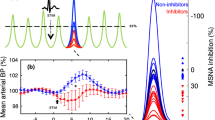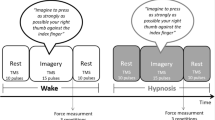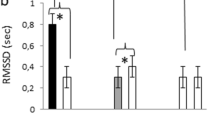Abstract
IT has been suggested recently that animals such as the cat and dog, when warned of an impending emotional or exertional task, anticipate the task with centrally induced cardiovascular changes similar to those that take place during the emotion or exertion itself1,2. Particular emphasis has been placed on muscle vasodilatation, preparatory to and independent of muscle contraction, mediated through sympathetic fibres supposed to be cholinergic, because the vasodilatation can be abolished by atropine1,3. Most of the data on which the “preparatory pattern” hypothesis is based, however, have been obtained by electrical stimulation of certain regions in the hypothalamus or subthalamus, from which are evoked either cardiac changes similar to those during exercise but without concomitant muscle activity2 or cardiovascular changes as well as manifestations of defence behaviour1,4. It should be realized, however, that the most quoted experiment on unanaesthetized, naturally behaving animals that may be relevant to this hypothesis, is that by Abrahams et al.5 which showed an increase in muscle venous temperature, blocked by atropine, when “alerting” was induced by various sensory stimuli. The evidence it provides, however, rests on unverified assumptions that the venous temperature increase accurately reflected muscle vasodilatation, that there was no muscle activity which could have provided a metabolic vasodilatation, and that the behaviour was one preparatory to exertion or emotion.
This is a preview of subscription content, access via your institution
Access options
Subscribe to this journal
Receive 51 print issues and online access
$199.00 per year
only $3.90 per issue
Buy this article
- Purchase on Springer Link
- Instant access to full article PDF
Prices may be subject to local taxes which are calculated during checkout
Similar content being viewed by others
References
Folkow, B., Heymans, C., and Neil, E., Handbook of Physiology, Section 2, Circulation, 3 (Amer. Physiol. Soc., Washington, 1965).
Rushmer, R. F., Handbook of Physiology, Section 2, Circulation, 1, 533 (Amer. Physiol. Soc., Washington, 1962).
Uvnäs, B., Handbook of Physiology, Section 1, Neurophysiology, 2, 1131 (Amer. Physiol. Soc., Washington, 1960).
Folkow, B., and Rubinstein, E. H., Acta Physiol. Scand., 65, 292 (1965).
Abrahams, V. C., Hilton, S. M., and Zbrozyna, A. W., J. Physiol., 171, 189 (1964).
Adams, D. B., Baccelli, G., Manica, G., Zanchetti, A., Proc. Commun. Twenty-Fourth Intern. Cong. Physiol. Sci., Washington, 6 (1968).
Stark, R. D., Nature, 217, 779 (1968).
Ström, G., Acta Physiol. Scand., 20, Suppl. 70, 47 and 83 (1950).
Author information
Authors and Affiliations
Rights and permissions
About this article
Cite this article
ADAMS, D., BACCELLI, G., MANCIA, G. et al. Cardiovascular Changes during Preparation for Fighting Behaviour in the Cat. Nature 220, 1239–1240 (1968). https://doi.org/10.1038/2201239a0
Received:
Issue Date:
DOI: https://doi.org/10.1038/2201239a0
This article is cited by
-
Neurally mediated syncope starting in old age does not appear to be unique to humans: new perspective
Clinical Autonomic Research (2022)
-
Clinical significance of stress-related increase in blood pressure: current evidence in office and out-of-office settings
Hypertension Research (2018)
-
Typical vasovagal syncope as a “defense mechanism” for the heart by contrasting sympathetic overactivity
Clinical Autonomic Research (2017)
-
The origin of vasovagal syncope: to protect the heart or to escape predation?
Clinical Autonomic Research (2008)
-
Alcohol, anxiolytics and social stress in rats
Psychopharmacology (1995)
Comments
By submitting a comment you agree to abide by our Terms and Community Guidelines. If you find something abusive or that does not comply with our terms or guidelines please flag it as inappropriate.



